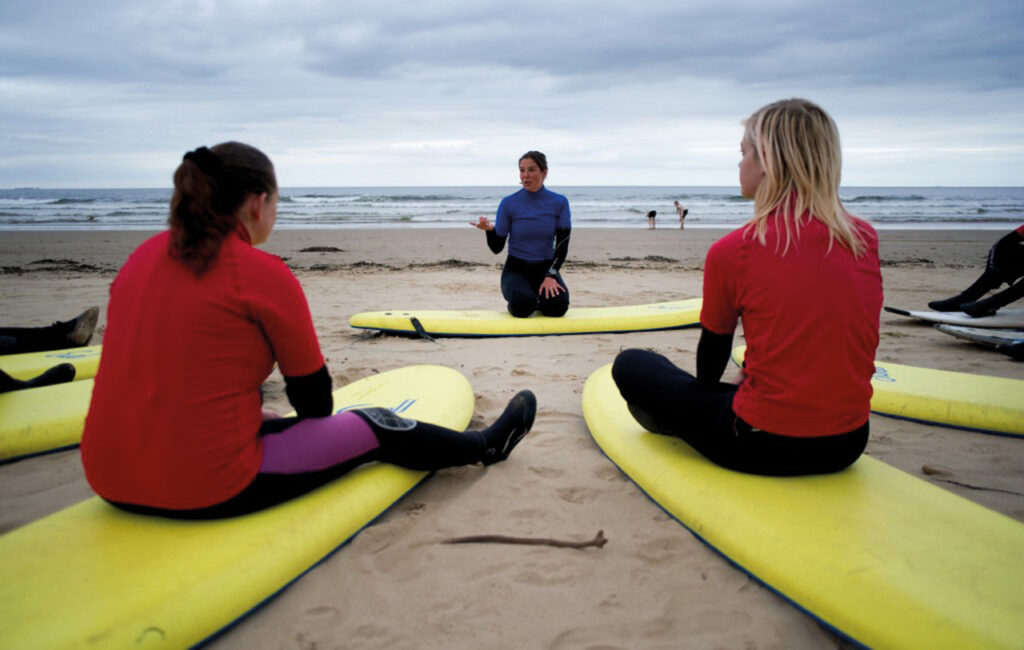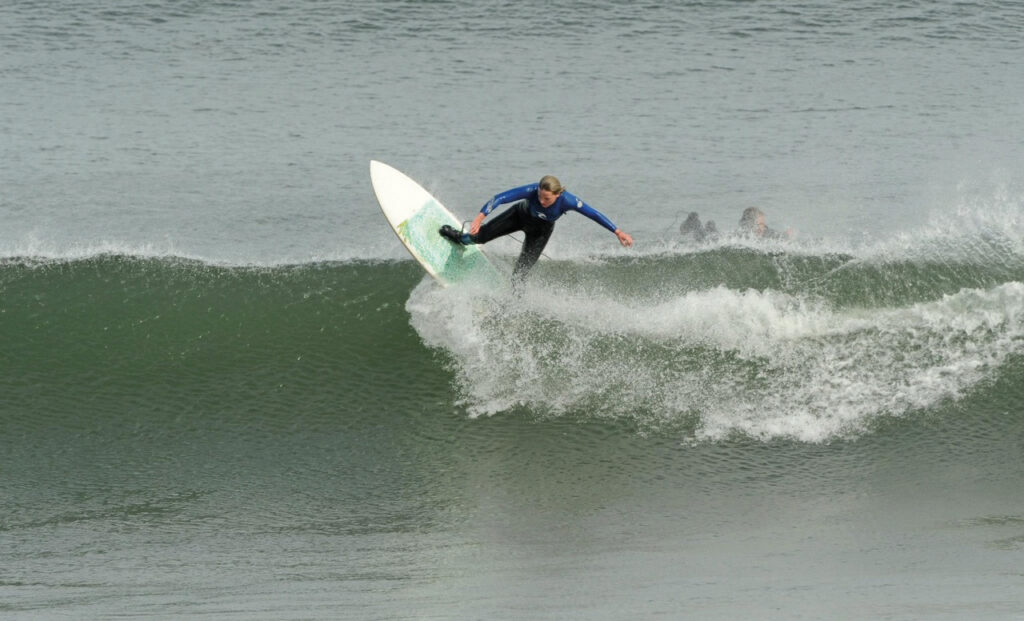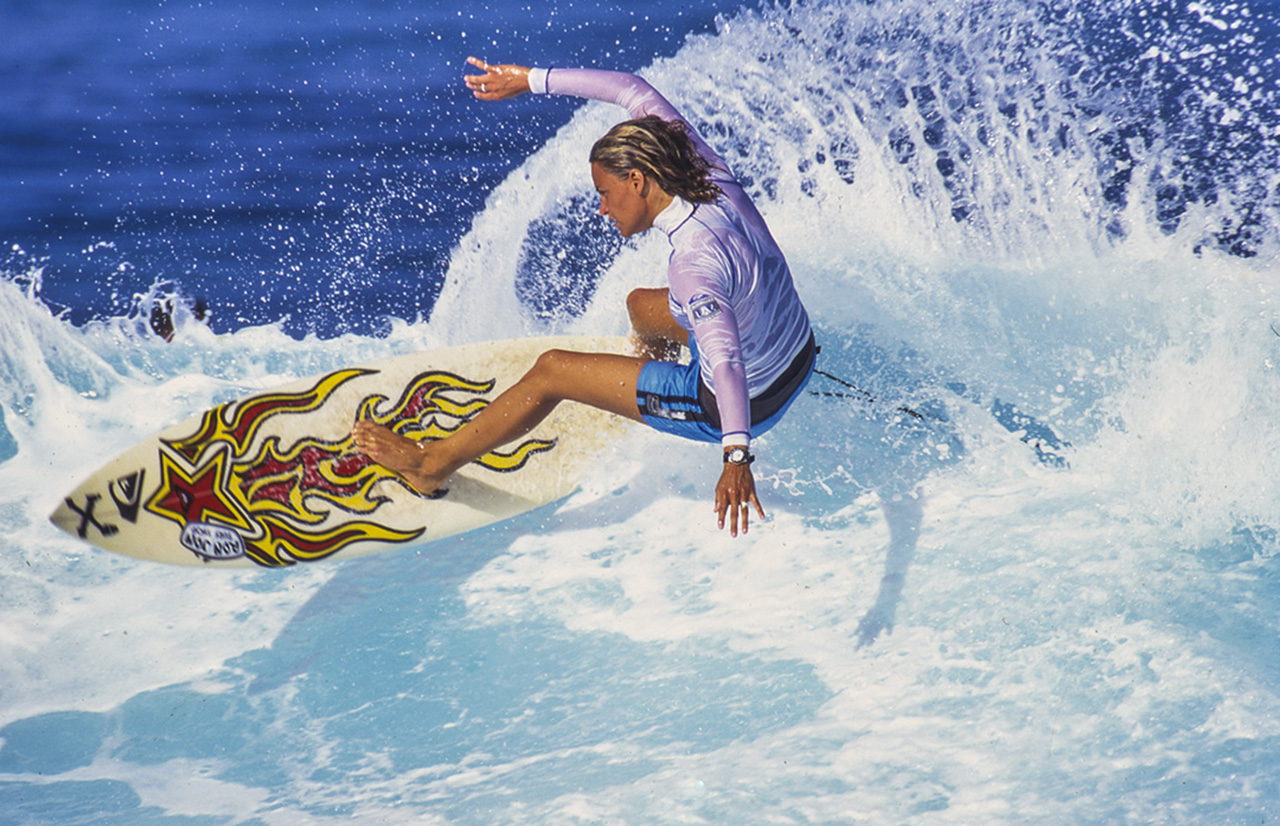Breaking waves
The pioneers of women’s surfing in the 1980s had to endure the awful sexism of the sport if they were to catch a wave. Now female surfers in the North are showing how far the sport’s moved on
Just as the Lionesses’ win at the Euros will inspire youngsters to kick a football, a new documentary called Girls Can’t Surf is sure to prompt women and girls to go catch some waves. The film provides an insight into the trailblazing female surfers of the 1980s and 1990s.
It’s a period when peacocking male surfers were regarded as nothing short of demi-gods while the women were forced to compete in bikini competitions on the beach when the surf was deemed too flat.
Amidst the big hair, and even bigger male egos, pioneering surfers such as Jolene and Jorja Smith, Jodie Cooper, Pam Burridge, Frieda Zamba, Wendy Botha, and Pauline Menczer tackled the sexism of their male peers, sponsors, and professional bodies – and for a tenth of the prize money awarded to their male counterparts.
To finally have a chance to tell their story must come as a relief.
“I was just really happy that someone wanted to pay any attention to what we did, and for our story to be told truthfully,” says Menczer, 52, from her home near Byron Bay in Australia.
Jodie Cooper recalls being punched in the face in 1989 by Hawaiian pro Johnny Boy Gomes
“It’s so important to show the history. That’s why Christopher [Nelius, the director] did the film. He’d talked to surfers like Tom Carroll and Ross Clarke-Jones, for another project, who described how tough it was to survive on tour. He thought if the guys thought it was hard, I wonder what it was like for the women, and whether the kids knew what had happened before them.”
Winner of the 1988 world amateur prize and women’s world champion in 1993, Menczer, who has suffered from rheumatoid arthritis for most of her life, overcame extreme adversity to reach the pinnacle of her sport.
She grew up in Sydney alongside her mother and three brothers following the murder of her father while he was working as a taxi driver. There was never any money, either as a child, or as an adult on the circuit.
“If you look at the headlines, it’s ‘The Perils of Pauline’ and ‘World Champion Has No Sponsors.’ I lived in a van during tournaments, but I was able to meet families around the world and stay with them on tour. It’s what you make of it, and I’m proud of what I’ve come from, and for doing it all myself,” says Menczer, who started surfing on one of her brother’s broken boards before progressing to a local surf club.
“I’d spend all day in the water, and just loved the whole lifestyle,” she recalls – despite the blatant sexism she encountered.
In the film, she recalls being kicked in the stomach by a male surfer. “They would yell out: ‘What are you doing out here? Girls should be on the beach.’”
In another clip, Cooper recalls being punched in the face in 1989 by Hawaiian pro Johnny Boy Gomes. “If you’re going to act like a man, I’m gonna treat you like a man,” she was informed.
Unsurprisingly Menczer felt the need to keep the fact she was gay a secret.
“As you see in the movie, I hid who I was for most of my career. But there are so many things that felt like the norm back then. Looking back, you just think it’s ridiculous.”
A turning point came during a competition at Jeffreys Bay in South Africa in 1999. In a silent protest, Menczer and her fellow female competitors refused to paddle out, and sat on the shoreline instead as the clock ticked down.
“The number of times I’d try and get the other competitors to do that before it actually happened, but one of the girls would get scared she’d lose her sponsorship. That day at J Bay there was no surf. They didn’t expect the men to surf, but as always, they expected us to, so we made a united stand,” she explains.
Some of those men are mortified by their past actions.
“Most of them say because they were so wrapped up in their own world, they never realised we struggled so much. Gary Elkerton apologised. He just went: ‘I was a dick head back then. I can’t even believe some of the stuff I said.’ Another surfer, Brad Gerlach, rang me up and said: ‘Can I give you some money now?’ No. But it was nice to create awareness of what went on,” says Menczer.
As recently as 2018, there was controversy regarding equal waves, equal pay when an image of Zoe Steyn being awarded half the prize money of the male surfer Rio Waida went viral on social media. The ensuing uproar resulted in the World Surf League announcing equal prizes for women from 2019.
“I remember bawling my eyes out with happy tears when I heard the news. A woman surfer could win three events and win the same amount of money I made in 20 years. The sport has just boomed,” notes Menczer, who worked as a school bus driver before Covid and is now a part-time carer. She refuses to feel bitter about the fact the same respect wasn’t granted to the women in her generation.
“My mum taught me there’s a positive in every negative. I just feel like things happen in your life for a reason and I like the person I’ve become from my challenges. But movies like this are so important. The young kids know me now, and say thank you for what you did. To know you’re helping a whole new generation is awesome.”
Following the film’s release in Australia, there is now a mural of Menczer at Bondi Beach, where she learnt to surf, and a crowdfunding campaign, called Pauline in Bronze, is underway to get a statue erected in her honour. But there are still problems in the sport.
“What I’d like to see is more roles where there are women at the top, and for men to be told when they’re being discriminatory,” says Menczer.
“For instance, at a local surf shop they’re selling a surf wax called Viagra with the tagline that says something like ‘Surf hard and longer’. It’s disgusting, so I wrote to the owner about it. He’s a nice guy. I just don’t think he’s thinking. But in general, I find the people who aren’t moving forward are either still living in the past and want it to be all about themselves, or are just uneducated.”
Although the women in Girls Can’t Surf hail from sunnier climes such as Australia, America and South Africa, women’s surfing has gained traction in the UK.
Surfing England has recorded that within the last three years over 500,000 women surf each year.
“In the 1980s and 1990s in the UK, with the exception of a few pioneering women in the surf, the role of the girls and women was as ‘surf support’, as in sitting in the vans watching the surf in the winter with a hot mug of tea or sitting on the beach in the summer,” says Rachael Percival of Surfing England.
“That began to change around 2000. We wanted to be in the sea rather than spectating and a few of us didn’t mind being the only ones in there. I think this began to change as surfing became more mainstream on the back of interest in extreme sports.”
Hannah Brand of Surfing England says: “Surfing is everywhere in the media now. Whether it’s a car or beauty advert, corporations are using surfing as a marketing tool. Whilst we’d like to see funds reaching actual surfing to make an impact to our surf communities and the sports development, there’s no doubt it’s driving more people to start surfing.”
Asked whether she believes sexism still exists, “the honest answer is yes,” says Brand. “On a personal level, the majority of ‘drop ins’ – when someone starts to ride the same open-faced wave when you have priority take off – are from men. Whilst I’m not shy to call them out, it’s frustrating, but it is getting better. I’ve had men recognise it’s my priority on a wave and let me have right of way, and told, ‘That last wave looked great.’ These positive encounters reinforce connections in and out of the water.
“The sport is evolving for women and we’re seeing more women’s surf clubs and surf coaching but one drive for us is to see more women in decision-making and management roles in surfing.”
Girls Can’t Surf is in cinemas now
Main image: Lisa Anderson

“I was in the army when I had my first opportunity to try surfing, and it instantly captured me. I was by no means a natural, but it was a bit like a dog with a bone, I just didn’t give up.
“To me, it is my time, my playtime. I can equally be frustrated, exhilarated, scared and immensely joyful all in one session. It is the power of mother nature and being immersed in it that is so important.
“I think awareness of surfing in the North East is definitely growing and we have an awesome female contingency of local surfers. I would say over the last ten years, women often outnumber the men.
“I think I must have been born at the right time, when most of the hard work was done for female equality, and that both my youth and adult life has not been affected by sexism. I own my own surf school, I coach all genders and receive equal respect, I am a course presenter for the International Surfing Association and work with coaches up and down our coastline.
“In truth I don’t believe my gender plays a role, my love of surfing does.”

“I’ve always loved the outdoors, especially the ocean, and was inspired to learn to surf by the classic movies and magazines. Now, I can’t get enough of it.
“There’s always been the stigma that surfers in the North East are mad as the sea is so cold but since coaching has become more accessible, more people have had a go and experienced how effective wetsuits are, and that stigma’s diminishing. And women’s surf wear has come on so much, thank goodness.
“There’s definitely been an increase of female surfers in the area. We actually have more girls than boys in our regular kids surf club. People are often surprised by the choice and quality of waves we have available, from beginner beach breaks to challenging reef breaks for the experts.
“If someone would like to learn to surf, I would recommend booking a lesson with a reputable Surfing England-accredited surf school to get started and also gain some local knowledge of the safest places to surf. We also recommend wearing a 5mm wetsuit and to start out on a foam surfboard.”
